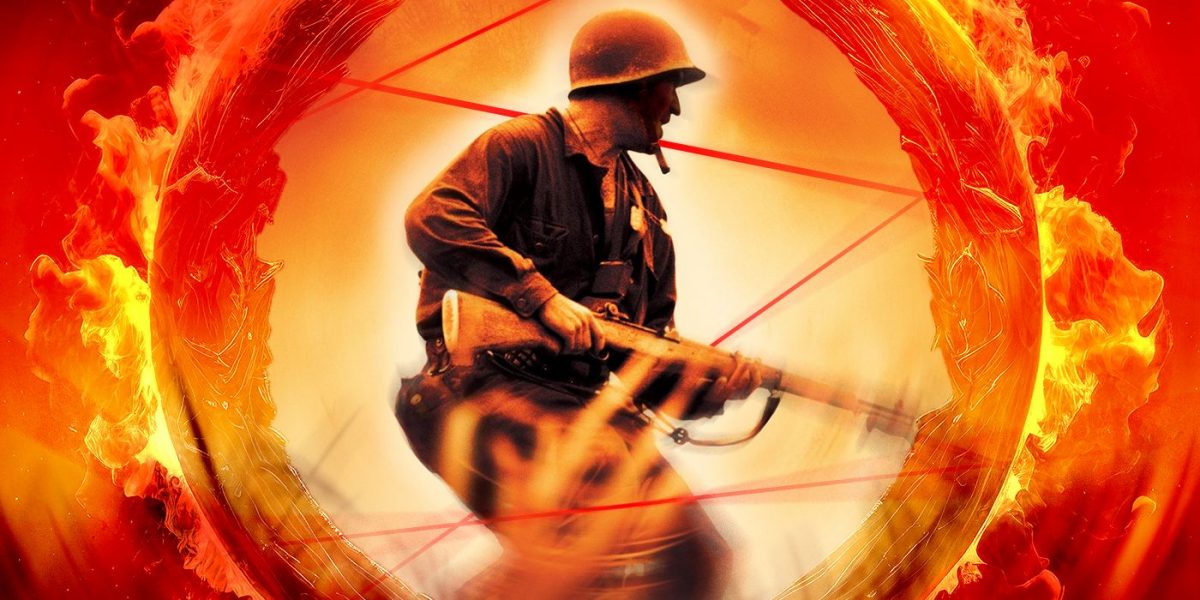
The Best World War II Battle Scene Is Not the One You’re Thinking Of
Nov 19, 2023
The Big Picture
The Thin Red Line highlights the brutality of war and the despair felt by soldiers, neglecting heroism in favor of universal despair. The film portrays the enemy as largely unseen and unknown, emphasizing the internal disarray and emotional toll on American soldiers. The juxtaposition of destruction and beauty in the film reflects the idea of war as a “Paradise Lost,” showcasing the breathtaking landscape of Guadalcanal alongside the horrors of combat.
World War II is arguably the last American conflict that the majority of Western civilians actually justify, even if the final blow of the atomic bomb was as tragic as it was, but even then, the biggest reason that Terrence Malick’s The Thin Red Line stands out among the best of the films it spawned is that its battle scenes devote so much time to the brutality of conflict in any form. While the best World War II movies will often showcase and praise the resilience of the victims, the best Vietnam movies act in full knowledge of the fact that it was a war that nobody wanted, marking a stain on the psyches of everyone involved. Terrence Malick righteously shoots The Thin Red Line with the same intensity as The Deer Hunter and Platoon, neglecting heroism in favor of universal despair, which is why the Battle of Guadalcanal, focused on throughout the almost 3-hour behemoth, is the best World War II battle scene ever put on film.
Oddly enough, in spite of its daunting runtime, The Thin Red Line acts as one of Malick’s more approachable works. Even with its narrative malleability and lack of a directly central protagonist, the stakes are made abundantly clear as its audience instantly knows who to “root for.” The concept, however, of a root-worthy protagonist in this particular Malick picture proves more than a little redundant, as the enigmatic director makes his message perfectly clear: that these soldiers, no matter how hard they fight, are far from heroes. On the contrary, they’re victims. Elem Klimov’s Come and See makes a strong case for being the most brutal war film ever made and likely still clears that bar with great pain in its heart, but The Thin Red Line brought that despair to the American perspective, and did it in a way that tore the values of warlike bravado apart.
The Thin Red Line Adaptation of James Jones’ autobiographical 1962 novel, focusing on the conflict at Guadalcanal during the second World War. Release Date January 15, 1999 Director Terrence Malick Cast Jim Caviezel, Sean Penn, Nick Nolte, Kirk Acevedo, Penelope Allen Rating R Runtime 170 minutes Genres Drama, History, War
‘The Thin Red Line’ Features an Unseen Enemy
It’s not so much that the antagonists of The Thin Red Line are abstract concepts but for the American soldiers marching across the warfront, they may as well be. One of the most ingenious choices that Malick makes throughout what’s arguably his largest production (I say arguably because this man threw full-fledged CG dinosaurs into a movie about childhood trauma and once tried to articulate the entire expansion of life and the universe as we know it in 45 minutes) is that the enemy is hardly seen throughout the American forces’ advancement up the hills of Guadalcanal. So much of the film is instead spent on the quietly internal disarray between American soldiers. Men contemplate life as they collect the dog tags off dead soldiers, serve water to the barely breathing, and struggle to bring supplies up to their checkpoint on the hill.
As they advance through thick bushes and tall blades of grass, bullets are flying their way, but us audience members, like the soldiers, have no visuals of the enemy. They’re as unknown and unseen as the demon of Skinamarink, yet when they finally do encounter them up close, they’re not what they expected. Instead of a thunderous hurrah at the sight of their fallen enemy, all the soldiers are left to witness is more carnage. Enemy soldiers commit suicide, search for their lost limbs, and crawl for life, ankle-deep in a sea of blood, until the only emotion the Allies are left with is remorse. Steven Spielberg attempted a similar brutality with Saving Private Ryan, most subtly poignant in the Battle of Normandy where the Allies come across two surrendering German officers. Except in spite of their uniforms, they’re not German, but Czech. The Americans, unsure of what language they’re speaking, shoot them on the spot, showcasing how the large majority of soldiers are wildly unable to comprehend the consequences of their actions.
The Best Scene in ‘The Thin Red Line’ Reflects the Soldiers’ Incompetence
Image via 20th Century Fox
Those who’ve seen the film likely already know the moment in question, featuring none other than Woody Harrelson in a brief but alarmingly powerful role. Harrelson stars as Sergeant Brian William Keck, an overzealous soldier whose eagerness gets the best of him when, in the middle of a firefight up a mountain, he accidentally removes the pin from a grenade on his belt. Terrified at the realization (as are all the men watching), he dives into the nearest dirt patch and takes the hit so that the blast doesn’t spread. This is probably the best example of foolishness and bravery intertwined ever put to film. If this happened on MASH the audience would be laughing for weeks, but is it comical? Absolutely not.
With this sequence, Malick is attempting to postulate the notion that war’s survivors and victims are primarily a matter of blind luck. You may have done your basic training and passed with flying colors, but when there’s nothing but a tiny pin separating you and the explosive force you carry on your belt, with bullets flying over your head at that, there’s only so much careful care you can apply. As Sergeant Keck falls to the ground, his men rushing to his aid, he wails in pain born from a mixture of shrapnel and humiliation. As he accepts his fate, he starts to grovel: “You write my old lady. You tell her that I wanted her to know that I died like a man.”
Even in Keck’s dying moment, his last concern is going out like a war hero, because the promise of a well-remembered sacrifice is all he has left. When Keck passes, the soldiers ask each other if they’re going to write to his wife. The answer: a simple, defeated “no.” In a world where “Every man fights his own war,” as the film’s tagline suggests, there’s no time afforded for helping one another. Only one’s self. Even with his short time on screen, the film remains one of Harrelson’s best performances, and a startling example of true anti-war cinema.
‘The Thin Red Line’ Juxtaposes Destruction With Beauty
Discussing the difficulties in getting the film made, producer Robert Michael Geisler references the team’s vision for Guadalcanal:
“The notion that we discussed endlessly was that Malcik’s Guadalcanal would be a Paradise Lost, an Eden, raped by the green poison, as Terry used to call it, of war. Much of the violence was portrayed indirectly. A soldier is shot but rather than showing a Spielbergian bloody face we see a tree explode, the shredded vegetation, and a gorgeous bird with a broken wing flying out of the tree.”
It’s a film designed to feel at odds with itself, emphasizing destruction and beauty in the same breath as this jaw-dropping tropical landscape is eviscerated by the machinations of combat.
Segments of the film thus feature Adrien Brody’s Corporal Geoffrey Fife, having deserted from his company to remain on the island of Melanesia, in total awe of the island’s beauty in spite of his temporal and spatial proximity to the most horrific sights he’s ever seen. This is helped largely by Hans Zimmer’s sweepingly beautiful score (undoubtedly among his best), bolstered by contributions from the Choir of All Saints from Honiara and the Melanesian Brotherhood of Tabalia. The choirs lend their voices to some of the most religiously beautiful choral music imaginable because while Malick indeed aims to provoke your despair, he also wants to remind you how obscenely beautiful our world really is. It’s a war movie devoid of glorification, yet one teeming with hope for a better future.
The Thin Red Line is available to stream on STARZ in the U.S.
Watch on Starz
Publisher: Source link
Can You Guess The Celebrity Based On A Photo Of Their Tattoos?
Hopefully, this quiz leaves a mark on you!View Entire Post › Disclaimer: This story is auto-aggregated by a computer program and has not been created or edited by filmibee.Publisher: Source link
Jan 5, 2025
Selena Gomez’s Celebrity Crushes Were Chad Michael Murray & Jesse McCartney
Selena Gomez's heart wants what it wants. And when she was younger, the Only Murders in the Building star's heart was reserved for her two major celebrity crushes: Chad Michael Murray and Jesse McCartney. In fact, she recalled a specific…
Jan 5, 2025
Alabama Barker’s $80k Christmas Haul Revealed
Meanwhile, Travis bought Alabama a pair of diamond earrings, as well as her third Cartier Love bracelet. Alabama said that Travis buying her a Cartier bangle “is kind of like a tradition now” as she explained that “every year” Travis…
Jan 4, 2025
Ice-T and Coco Celebrate Their “Sexy” 24th Marriage Anniversary
Ice-T and Coco Austin are ringing in a major milestone. The Law and Order: Special Victims Unit star and the model, who are parents to daughter Chanel Nicole, 9, not only celebrated the start of 2025 on Jan. 1 but…
Jan 4, 2025











